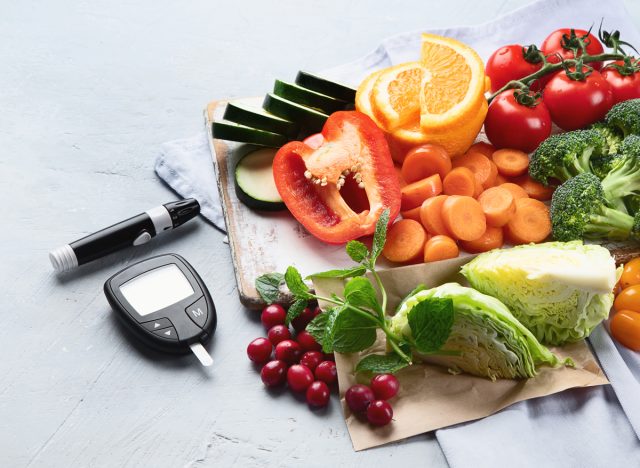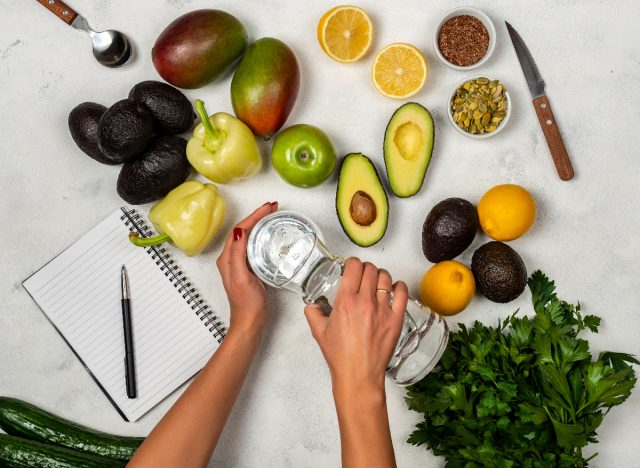What and how you eat directly impacts your risk of developing type 2 diabetes. So, it's simple logic to make a habit of reducing the stuff that most directly leads to the deadly disease: sugar.
An estimated 34 million Americans have diabetes, more than 10% of the U.S. population, according to the National Institutes of Health. Another 88 million adults or 34.5% of Americans have prediabetes, a disorder characterized by blood sugar levels that are high but not yet to the level indicating type 2 diabetes.
When your body doesn't produce enough insulin or uses it ineffectively to keep your blood sugar in a healthy range, that's called insulin resistance. Your cells become numb to the hormone and can't efficiently use glucose for energy. Insulin resistance often leads to type 2 diabetes.
The disease is so common (as the numbers above suggest) that many people may not be aware of how serious and frightening it is. Type 2 diabetes is associated with obesity, cardiovascular disease, nonalcoholic fatty liver, and dementia.
If understanding the devastating potential outcomes of a diabetes diagnosis has renewed your interest in being more aware of your sugar intake, great! But here's another idea: Instead of focusing on cutting carbs and sugars out of your diet, establish eating habits that prevent diabetes. Since sacrificing the foods you love can be so unpleasant, focus on how you can eat healthy without denying yourself. That gets to the most crucial eating habit for avoiding diabetes, according to many nutrition experts:
Eat as if you already have diabetes.

"The diet we should all be on is the optimal diet of people with diabetes," says registered dietitian nutritionist Wendy Bazilian, Dr.PH, RDN, a doctor of public health and exercise physiologist certified by the American College of Sports Medicine. "You want a stable, steady release of blood glucose to enter the cells to make energy efficiently."
This is because stable blood sugar is critical to optimal metabolic health. And it affects many facets of your overall health—your energy, sleep, mood and cognition, and immune system function.
"Uneven eating patterns, like skipping meals and eating heavily at dinner because you're starving, cause too many blood sugar spikes, which increases risk for diabetes," says registered dietitian Catherine Sebastian, MS, RD, manager of health communications at The Wonderful Company.
That advice may sound radical, but it's very logical and doable, because it's essentially the same healthy eating style that supports heart health, reduces inflammation, prevents weight gain and obesity, and reduces risk of certain cancers.
Another important thing to consider when "eating like you already have diabetes" is that you don't need to cut out carbs completely.
"Cutting out carbs is a misconception," says Sebastian. "You want carbohydrates that contain fiber. And you should always have a protein source in every meal."
And some fat, adds Dr. Bazilian. "Have protein, fat, and carbs in your meal." Having the three macronutrients ensures you're getting nutrients, including fiber, that slow the absorption of sugars into the bloodstream as well as promote satiety.
How to start this habit
Making a habit of eating like someone who already has diabetes can be challenging, just as establishing any routine can be. The key is to make a decision to commit to your health and well-being before making any changes to your day-to-day life, says Nick Frye, MS, a licensed clinical professional counselor and behavioral counseling manager for OPTAVIA, a weight loss and health coaching company.
The first step is finding your "why," "which is what we call the fundamental choice," he says. "It's an intentional commitment to identifying and following your north star. It's a mindset shift that sets direction and foundation for future action. All other habits to come are made in service to your fundamental choice."
So, for example, if eating like a diabetic is the habit you want to adopt, the first step is to determine what you want to get out of that habit. If it's "to optimize my health and avoid diabetes," personalize it with something emotionally meaningful to you, like "so I can be healthy enough to dance at my granddaughter's wedding in 20 years."
"Mindfully and intentionally become the author of your story," suggests Frye. "Skipping this mental exercise and jumping prematurely into action may deliver temporary success but is likely to result in long-term failure."
Next step: taking baby steps

Remember Newton's First Law of Motion? A body at rest will remain at rest unless acted upon by an outside force. Well, that's the principle behind habit creation: you must start moving and then keep moving. Frye recommends starting small with micro-habits because "small, repeatable behaviors lead to significant results. Habits set people up for sustainable change."
You can find advice on how to eat like a diabetic on the American Diabetes Association website and elsewhere. But to start, build these micro-habits into your day and see where they take you.
Eat something within the first hour of waking.
"Put something in your mouth, break your fast," advises Carly Knowles, MS, RDN, a registered dietitian nutritionist with Organic Valley, an independent cooperative of organic farmers. "It fixes so much. It sets a mindset shift that food is a priority."
Knowles also works in private practice with women with gestational diabetes. She says her golden piece of advice to them is to eat for energy in the morning. "It's not so important what you eat but that you eat—could be five almonds or a few spoonfuls of yogurt—something. Otherwise, you may get to lunch with a blood sugar crash, causing brain fog, cravings, and binge eating."
Go half and half.
If you're trying to avoid white bread by switching to 100% whole wheat but are having trouble making the switch, go half and half. "Make half of your daily grains whole grains and half refined grains that are enriched," suggests Elana Natkier, MS, RD, a registered dietitian and consultant to the Grain Foods Foundation.
Eating the enriched bread won't increase your risk of diabetes, and it will ensure you're getting the added iron, folate, vitamin A, and thiamine. Natkier points to a 2019 analysis of studies in Advances in Nutrition, which found no association between refined grain intake and risk of type 2 diabetes when comparing the highest and lowest intake groups.
Take a stand.
Brazilian also recommends establishing this micro-habit: Stand up after you finish a meal. The act alone marks a transition and signals to your brain that the meal is completed. "Standing up starts the mechanics of digestion and it starts to tell our cells to open up to receive blood sugar," Bazilian adds. For the same reason, go for a walk after every meal. She cites a study in Sports Medicine, showing that even just two minutes of walking after a meal can improve blood sugar levels when compared to sitting or laying down.
Drink this.
Have a glass of water before every meal. It'll likely satisfy the intense hunger and help you avoid overeating. "Eating too much food can also make your blood sugar out of balance," says Bazilian. Too much of any one macronutrient can be detrimental to health, too.
No comments:
Post a Comment